| 1 | Gold-ringed catsnake |
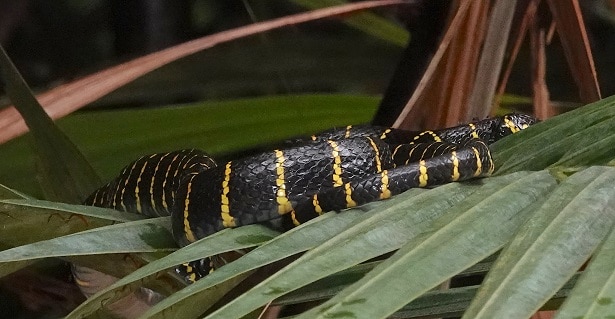
The gold-ringed catsnake (Boiga dendrophila) is a southeast Asian species which is impossible to miss. They’re not only completely different to most of their Boiga catsnake family, but look like no other snake nearby.
Gold-ringed catsnakes inhabit eastern Malaysia, Borneo, and parts of Indonesia such as Java and Sulawesi. They inhabit mangrove forests, but lowland rainforest just as commonly. Gold-ringed catsnakes have a jet black body with thin yellow bands, and a yellow face below the mouth, itself streaked with black markings.
According to a 2006 study, Boiga dendrophila produces a rare toxin called denmotoxin that specifically targets bird prey. There’s also a powerful neurotoxin called boigatoxin-A, discovered in 2005. When injected into mice, this prevented electric-inducted twitches of the muscle, with the result in the real world being paralysis. The only drawback is that they’re rear fanged, and must orient their mouth awkwardly to inject venom into a victim.
Gold-ringed catsnakes have an unpredictable temperament, so if you recognise one sitting in its tree branch (which isn’t hard), stay well back. This species is nocturnal, barely moving during the day and activating the moment the sun sets. Those yellow stripes aren’t visible signs of the neurotoxins pulsing through their body, just colourful patterns.
| 2 | Tiger ratsnake |
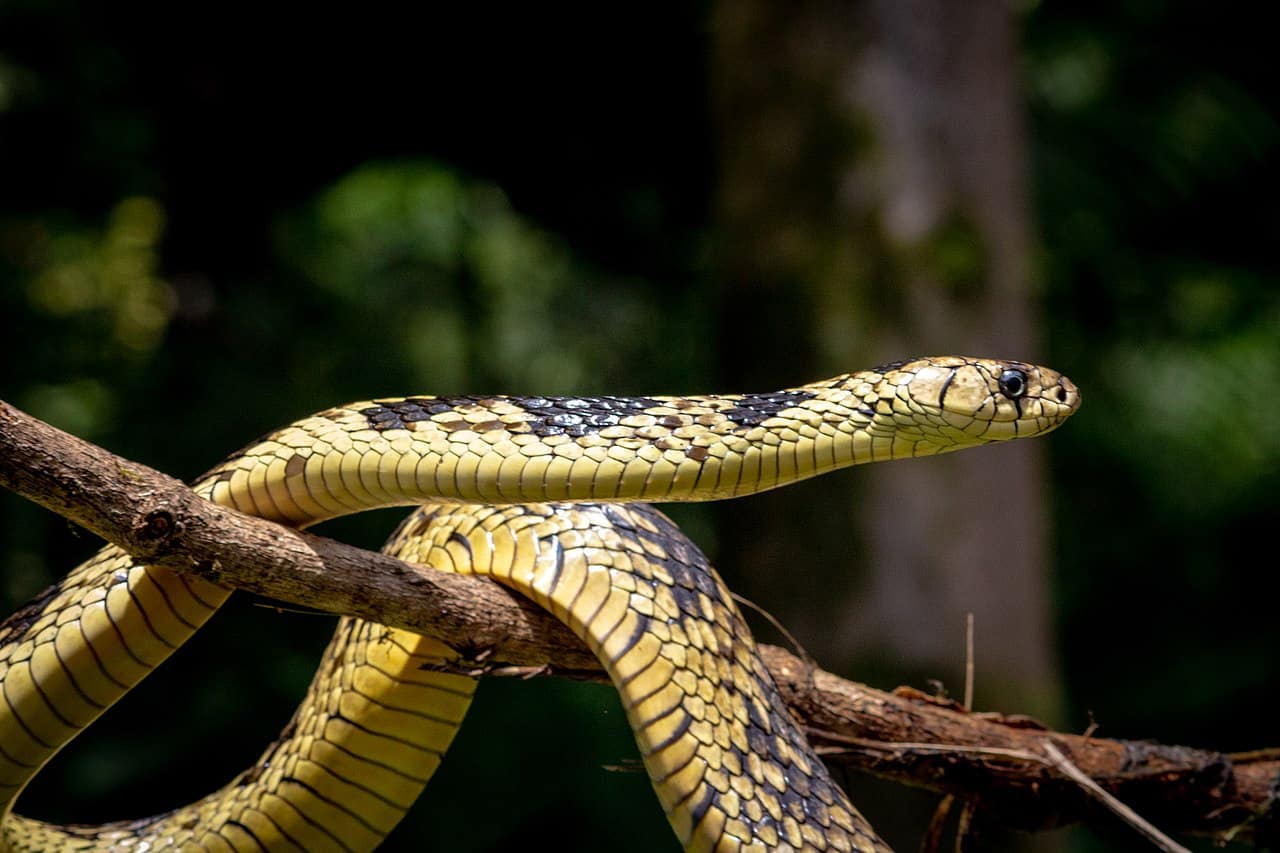
One of South America’s most common snakes. The tiger ratsnake reaches 2.5 metres and is strongly yellow-black, though nobody is sure why. Camouflage isn’t the reason, as this is an adventurous snake which strides confidently through open territory.
Tiger ratsnakes aren’t afraid of humanity, and can move through farmlands and villages with ease. This is a strongly diurnal snake, moving from 7:00-17:00 and almost never at night. Black and yellow are virtually the only colours they have, as their tongue and eyes are also black. That said, the exact patterns varies – in some the yellow covers more area, while in others the black spreads its tentacles.
Tiger ratsnakes swallow smaller prey alive, whereas larger prey are constricted, or pressed against the floor until they weaken (or escape). Tiger ratsnakes can reach branches 10 metres high in their quest for birds, but 90% of their prey consists of mammals. They’re also bat-eating snakes, which will investigate a cobweb-filled rooftop just to locate them. Tiger ratsnakes have one of the largest territories of any snake, ranging from eastern Mexico to northeast Argentina.
| 3 | Yellow-bellied sea snake |
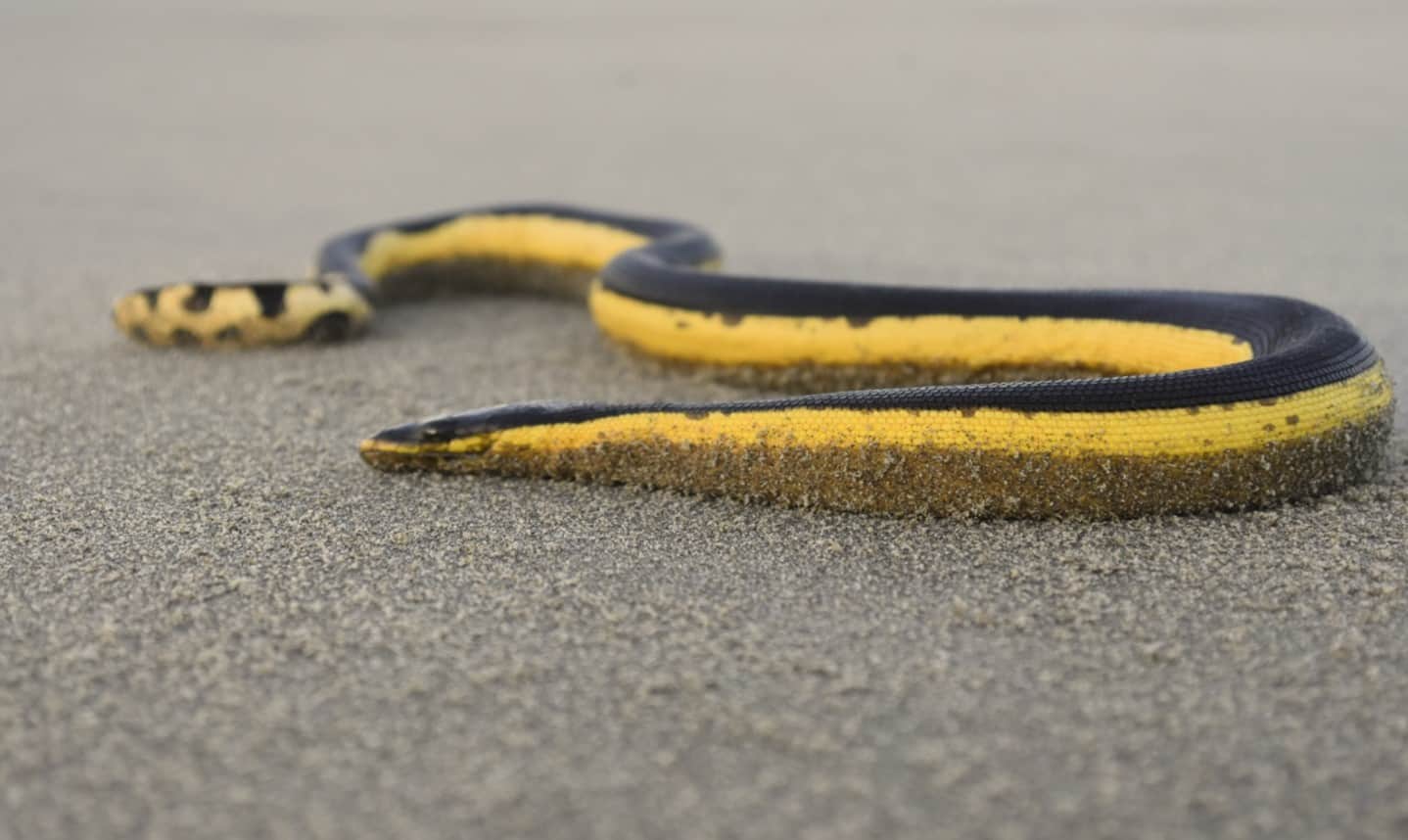
A snake of the open seas, and one of the easiest to recognise as it floats past your lost fishing boat. This species measures 70-80cm and lives from eastern Africa, through Australia, to the Pacific coast of central America.
The yellow-bellied sea snake is purely black and yellow, with no room for subtleties in between. For most of their body, they possess a clear separated pattern, until their paddle-shaped tail arrives, and the dividing line becomes a distorted series of wavy loops. The face is also cleanly divided, with the border of the yellow lying just below the eye (which is also black).
Unlike tiger ratsnakes, the yellow-bellied sea snake’s colour has a clear explanation. Their hunting strategy is to float on the water surface, sometimes amidst sea slicks of foam and rotting vegetation. By wiggling their tail, they lure curious fish in, which they devour with a sudden lunge. The problem is that this leaves them exposed to hungry sea birds. With a black back and yellow belly, they can simultaneously blend into murky ocean depths and the sun-reflecting water surface, when viewed from above and below.
| 4 | Usambara eyelash viper |
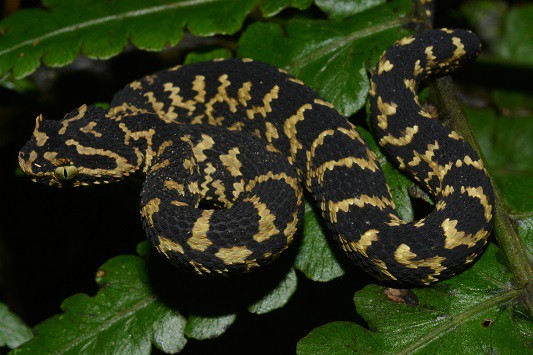
The hairy bush viper is one of the internet’s favourite bizarre snakes, as it looks like a pineapple come to life, with razor sharp scales. The Usambara eyelash viper (Atheris ceratophora) belongs to the same family, yet lives solely in Tanzania, at elevations of 700-2000 metres. It has several differences, the first being elongated “eyelash” scales directly above each eye, giving it a flirty (yet evil) look. The second is a tendency to be purely black-yellow with no colours in between.
This snake has a thin neck, and is a tree climber, but tends to stay 1 metre above the ground. Usambara eyelash vipers prey on frogs, and reach a maximum of just 54cm, with females being longer. This snake has several morphs – some have more intermingling black-yellow scales, while others have vividly contrasting stripes. In this snake, the black is reduced to a faint sprinkling on the yellow like charcoal.
Usambara eyelash vipers live in the namesake Usambara mountains, which formed in Tanzania an estimated two million years ago. These are free from glaciers, and are instead covered in a vast sea of tropical forests. The mountains have an unusually high amount of rare species – we’ve just discussed one, and others include the Usambara eagle-owl and Usambara forest toad.
| 5 | Samar cobra |
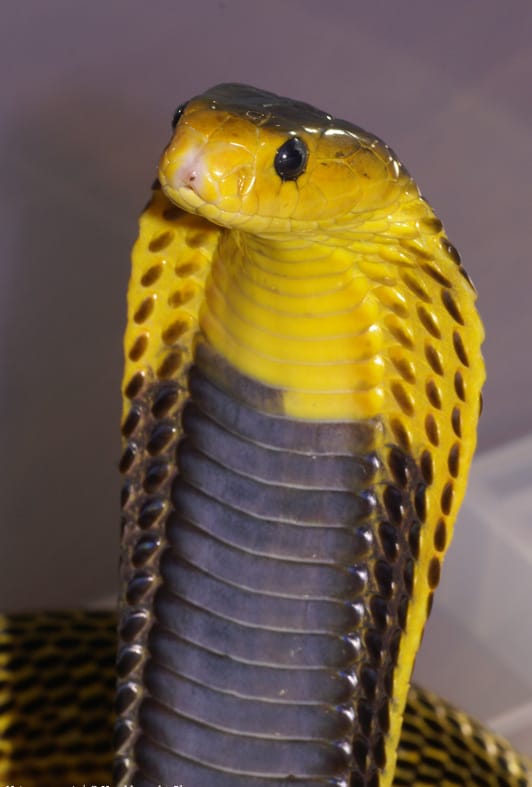
The Samar cobra looks like a curious and inquisitive snake, and they likely are, but this doesn’t mean that they wish you well. Samar cobras (Naja samarensis) reside in the Visayas and Mindanao islands of the southern Philippines, and are the most consistently black-yellow of the Naja cobra family. Their chest and head are a bright lemon, while their black body has intermittent yellow speckles, all contrasting extremely vividly like a treasure chest glowing in darkness.
Samar cobras reach 1.4 metres, and are as flexible as most cobras. They can inhabit forests and marshes, or lurk on village outskirts, blocking every road from north to south. Rice paddies are a particular hotspot, bringing them into conflict with farmers.
The samar cobra is a spitter. Unlike an Egyptian cobra, they have specialised front-facing hollows in the tips of their fangs, which force venom through in pressurised jets. A globule in the eye can cause permanent blindness if the victim doesn’t reach a doctor quickly enough. They also have a normal bite, which is primarily neurotoxic in nature. Opinions differ on their personality. Some believe that they’re timider than the Philippines cobra on the northern Filipino islands, while others deem to them to be nervous and agitatable.
| 6 | Shropshire’s puffing snake |
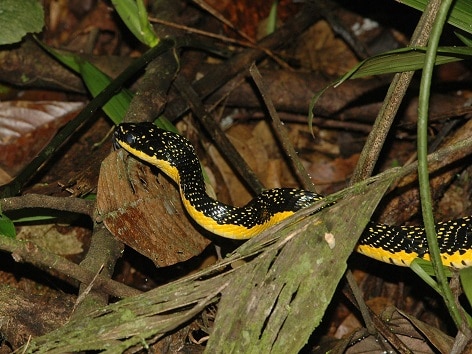
The puffing snake is a powerful species in South America, but this is their less common cousin. Shropshire’s puffing snake is a strong climber, which raids birds nests for hatchlings and maybe the eggs. This snake mainly dwells in Ecuador and Columbia, west of the Andes. Shropshire’s puffing snake is cleanly divided, with black on the back and yellow on the belly. But scales of each colour spill into the other’s territory, with yellow speckles here and there.
Phrynonax shropshirei is a bird hunter, which is confirmed to hunt social flycatchers by slithering into roofs. This bird is almost as black-yellow as they are, so it’s like they’re jealously protecting their turf.
Shropshire’s puffing snakes are non-venomous, but have a complicated intimidation display. They can throw the upper 1/3 of the body into a taut S-shaped coil, with the tail gripped firmly around a branch. This coil hovers in mid-air rather than touching any part of the ground. They can compress their sides to make their body deeper, and spread their lower jaws to alter their head shape. Shropshire’s puffing snakes also hang their mouths wide open, to increase the intimidation factor further.
| 7 | Yellow anaconda |
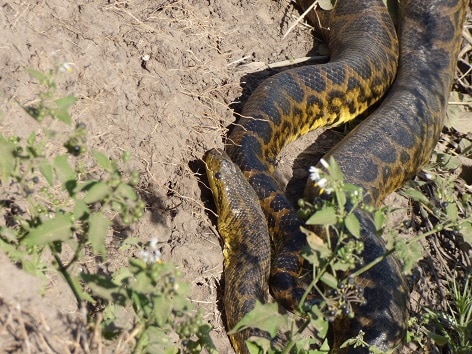
A separate species to the notorious, scientist-swallowing green anaconda (Eunectes murinus). Yellow anacondas live further to the south, inhabiting forested wetlands surrounding the vast Paraguay River and its many tributaries. Yellow anacondas are the shorter of the two, but still reach 4 metres, with a maximum record of 4.6 metres in females.
Yellow anacondas (Eunectes notaeus) love shallow water most of all, weaving through thick jungle strands through endless corridors of standing water. They lurk below your feet, but their yellow colours make them easier to see than green anacondas. Eunectes notaeus varies from sharply contrasting black/yellow, to a shimmering golden sheen, like the royal family of yellow anacondas.
Yellow anacondas have a wide diet, but prey most heavily on birds. Their favourites include streaked herons, cattle egrets and guira cuckoos. Their mammal prey include large vesper mice and Chacoan marsh rats, while fellow snake prey include the Brazilian smooth snake. Despite their brute size, yellow anacondas are relatively inactive, moving just 188 metres per month according to a 2020 study.
| 8 | Western mangrove catsnake |
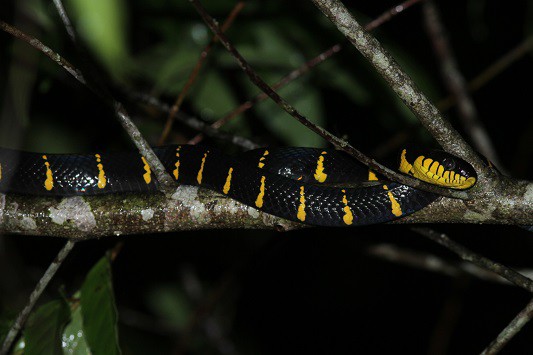
An extremely close relative to the gold-ringed catsnake. Mangrove catsnakes (Boiga melanota) were originally a subspecies, but elevated to their own species-hood in 2020. Boiga melanota lives further west than its cousin, taking over the empire in peninsular Malaysia, Singapore, southern Thailand and Sumatra. Their habitats are similar, including mangrove swamps and moist forests, as are their branch-resting ways.
At first glance, they’re indistinguishable. Yet the difference is actually extremely simple – with Boiga melanota, the thin yellow stripes never meet in the centre of the snake’s back. There’s always a gap along the mangrove catsnake’s spine, whereas with Boiga dendrophila, the yellow stripes fuse. Many people with captive black-yellow catsnakes may not know the exact species – check the spine and you’ll know.
Another sign with Boiga melanota is the lack of yellow spots on its dark belly scales. Does any part of their body have a different colour? Yes – their tongue is a dull fleshy pink, far less vivid than the rest. This is a similar colour to the pink inside of their mouth.
| 9 | Jungle carpet python |

This snake’s colour scheme is yellow on top of black on top of yellow. The jungle carpet python is a subspecies of the main carpet python, known as Morelia spilota cheyni. It shares biological attributes like being a thick-bodied constrictor, and primarily eating mammals. The main difference is its beautiful colour scheme, which has led to a particular popularity as a pet. In 2011, a New Zealand man was sentenced to 4 months in jail for illegally importing one (all snakes are banned in New Zealand).
Jungle carpet pythons live in Queensland rainforests, particularly the Atherton mountains, at the northeast tip of Australia. Their patterns are yellow overlaid with wonky black blotches, which themselves have yellow speckles in the middle. Their eyes are also black, with a blue-grey tongue being the sole exception.
Adult jungle carpet pythons generally reach 1.5-2.1 meters, but occasionally a giga-python will be dragged out of the jungle measuring 2.6m. This species can easily reach 20 years old, and the flipside to their beauty is their temperament, as this is the bitiest of the carpet python subspecies.
Jungle carpet pythons actually grow more colourful with age. Initially, they’re grey and white, and after a few weeks the first yellow stripe appears. With each skin shed, there’s a gradual intensifying, until they finally burst into the yellow-black superstardom of adulthood.
| 10 | Manchurian black ratsnake |
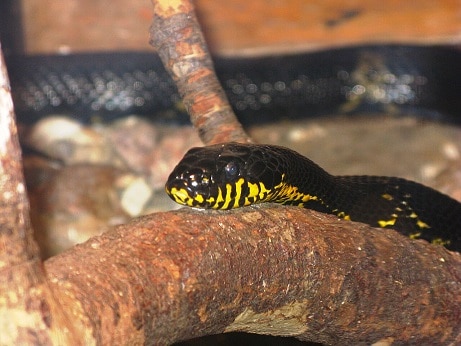
This is the most black-yellow ratsnake of Eurasia, particularly around the face. The black is constant, but as the head approaches, the creamy patches between darken to a vivid yellow. This also depends on the morph, as Manchurian black ratsnakes vary significantly in the wild. The black-yellow colours continue to their belly, but switch to a rapidly alternating checkerboard pattern, instead of occasional stripes.
This species reaches 1.4-1.8 metres, and is non-venomous, constricting its prey. They feed on mammals, but also birds and their eggs – in captivity, they happily swallow up quail eggs. Manchurian black ratsnakes naturally inhabit forests, forest edges, and mixed bushy and thorny plains. Anywhere with vegetation, in other words, and their name is misleading, as most of their range only covers extreme eastern Russia, also reaching South Korea, Mongolia and northern China.
This is one of the calmer ratsnake species. In captivity, they will sit at the edge of a terrarium and watch their keeper inquisitively, and slither around amiably, flecking their tongues at any object that interests them. As juveniles, they’re more flighty and nervous, but by adulthood they become perfectly peaceful. Elaphe schrenkii tolerates colder temperatures much better than some – keepers recommend 21-28C.
